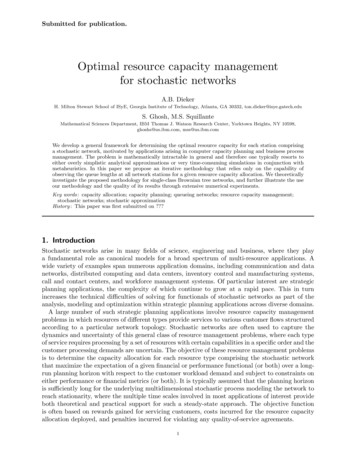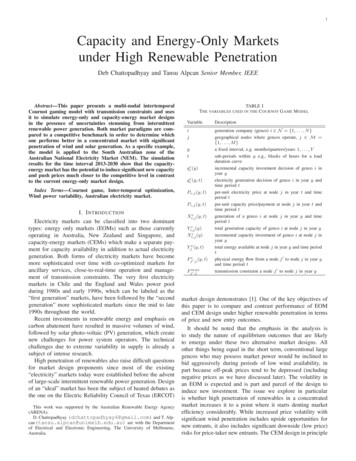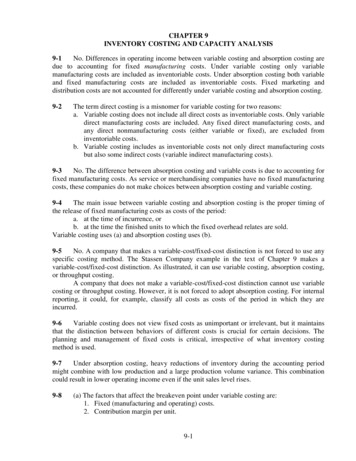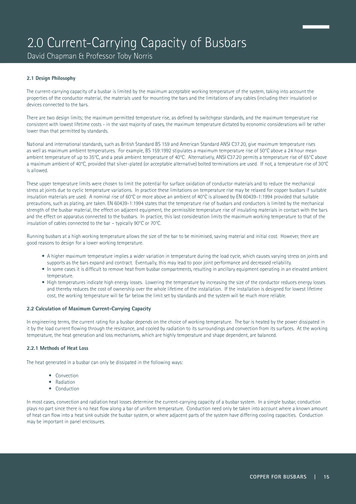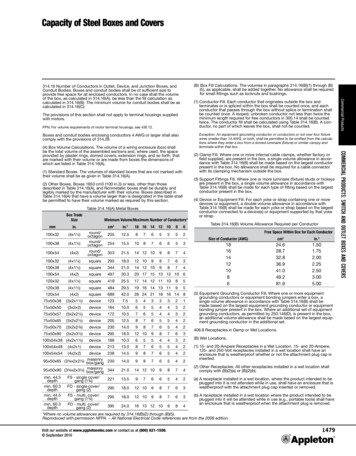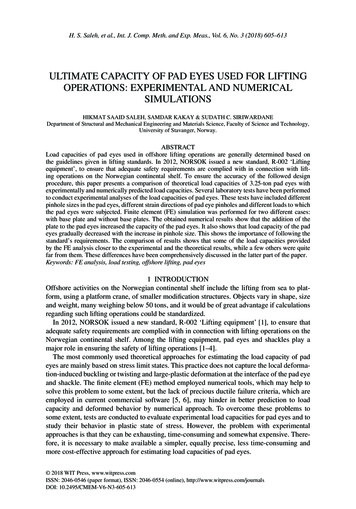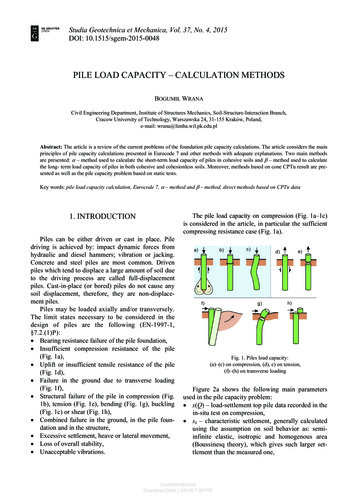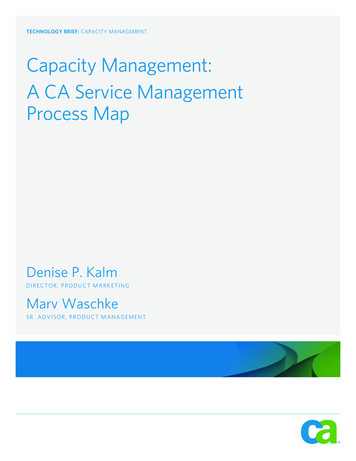
Transcription
TECHNOLOGY brief: CAPACITY MANAGEMENTCapacity Management:A CA Service ManagementProcess MapDenise P. KalmDirector, Product MarketingMarv WaschkeSr. Advisor, Product Management
Table of ContentsExecutive Summary1SECTION 1: CHALLENGE2Simplifying ITILHow to Use the CA Service ManagementProcess MapsFinding the Right Path to IT Service ExcellenceSECTION 2: OPPORTUNITY4Capacity ManagementCapacity Management Sub-ProcessesMonitor DemandAnalyzeMonitor PerformanceForecastCreating the Capacity PlanNew Services (Application Sizing)ProcureLoad TestAdjustDemanding Management—A Form ofAdjustmentSECTION 3: BENEFITS12Benefits of Capacity Management BestPracticesSECTION 4: CONCLUSIONS12Section 5: about the author13ABOUT CABACK COVERCopyright 2009 CA. All rights reserved. All trademarks, trade names, service marks and logos referenced herein belong to their respective companies. ITIL is a Registered Trademark and a Registered Community Trademark ofthe Office of Government Commerce, and is Registered in the U.S. Patent and Trademark Office. This document is for your informational purposes only. To the extent permitted by applicable law, CA provides this document “As Is”without warranty of any kind, including, without limitation, any implied warranties of merchantability or fitness for a particular purpose, or non-infringement. In no event will CA be liable for any loss or damage, direct or indirect, fromthe use of this document including, without limitation, lost profits, business interruption, goodwill or lost data, even if CA is expressly advised of such damages.
Executive SummaryChallengeThe Information Technology Infrastructure Library version 3 (ITIL V3) process frameworkaddresses the IT Service Management (ITSM) service lifecycle. The Service Lifecycle is anorganizational model providing insight into the structure of ITSM, with critical guidancefor IT organizations seeking to improve service quality and align closely with business tocreate customer and business value.However, ITIL V3 best practice guidelines for the five phases of the service lifecycle arecomplex and challenging to interpret. Moreover, they do not provide definitive guidancefor implementing ITSM processes. Many IT organizations consequently undertake an ITILjourney without firm goals or plans.Too often overlooked, the ITIL Capacity Management process focuses on proactivemanagement of capacity and performance. It provides critical support for many otherprocesses, such as Availability, Service Level, Financial, Problem, and more. As such, it is acritical process. The quality of an organization’s Capacity Management can make or breakits reputation with its customers.OpportunityCapacity Management seeks to optimize IT capacity to meet Service Level Agreements(SLAs) in the most cost-effective manner. Capacity Management proactively ensuresthat an IT infrastructure will meet both current and future business demands. Gatheringand analyzing relevant data, Capacity Management helps plan for upcoming needs andoptimize purchasing decisions—continuously balancing cost against capacity, and supplyagainst demand. CA has developed a unique approach to representing the ITIL frameworkand its interdependent ITSM processes at a high level in the form of an easy-to-usesubway map. This map is an ideal starting point for understanding and communicatingabout ITIL in support of successful planning and implementation.BenefitsThe CA Capacity Management process map enables IT organizations to manage by: Spending money on the right things at the right time Utilizing the systems and budget you have in the most effective manner Giving you the tools to proactively reduce system incidents and problems Increasing customer satisfaction Anticipating capacity requirements before business is adversely impacted Reducing the threat of service degradation through better resource management Diminishing the risk associated with changes to the IT infrastructureTechnology Brief: Capacity MANAGEMENT 1
Section 1: ChallengeSimplifying ITILThe ITIL V3 process framework focuses on the service lifecycle and the structure and linkageservice management components. It embodies critical guidance for IT organizations that areseeking to improve service quality and align more closely with business goals.But, the ITIL V3 best-practice guidelines across the five phases of the service lifecycle arecomplex and challenging to interpret. Moreover, they are not designed to provide definitiveadvice about implementing IT Service Management (ITSM) processes. Many IT organizationsconsequently undertake an ITIL journey without a firm idea of their goals and the path toachieve those goals.CA has developed a unique approach to charting the ITIL journey through a visualrepresentation of the ITIL framework and its interdependent ITSM processes modeled after anurban subway system. This three-part map (Figure A) presents an easy-to-navigate, high-levelview of the ITIL terrain. IT executives, strategists and implementers can use these ServiceManagement process maps along with the family of CA Service Management process maptechnology briefs that expand on them. The maps and technology briefs provide a commonreference point for understanding and communicating about ITIL and help you with programplanning and implementation.How to Use the CA Service Management Process MapsCA’s Service Management process maps (Figure A) illustrate every process (or track), eachactivity (or station) and the key relationships that are relevant to navigating continuous ITservice improvement. The ITIL quality cycle takes the form of a “circle” with each Plan-DoCheck-Act (P-D-C-A) step as a process integration point (junction) on the line. Junctionsserve both as reference points when assessing process maturity, and as a means to considerthe implications of implementing a process in isolation.Strategic controls (Service Portfolio Management, Demand Management and FinancialManagement) are needed to reduce risk and optimize integration across the service lifecycle,as illustrated on the three points of the triangle centered in the P-D-C-A quality circle (seenmore easily in Figure B). These strategic controls help in evaluating, prioritizing and assuringthe appropriate levels of financial and human resources for existing and new services.This paper is part of a series of Service Management Process Map technology briefs. Each briefexplains how to navigate a particular ITIL process journey, reviewing each process activitythat must be addressed in order to achieve process objectives. Along each journey carefulattention is paid to how technology plays a critical role in both integrating ITIL processes andautomating ITIL process activities.2 Technology Brief: Capacity MANAGEMENT
Service OperationService TransitionService CatalogManagementMaintainBusinessServicesRelease andDeploymentManagementTestCAB sourcesMonitorServicesServiceValidationand TestingMaintain AccurateService AuditResponsivenessValidate &VerifySpecifyContinuityRequirementsANPLIT factionPublishLive tizeChangeManagementSelect ResponseRecordAutomateand ControlAReviseSLAs / OLAsManageIssuesOptimizeAvailabilityDetect(Incl. Fault Detection)Review/ActionStore Info.Service sformto UsableKnowledgeVerifyAccess RequestReviewand AuditMitigate RiskDemandManagementExecutivePolicyFilter erabilitiesBuild dgeTransferPLAssess luePreparationPreparationand PlanningManageSecurity IncidentsCTDDevelopStrategyCHBuild CatalogContentsTestCHService nitionService erformanceCHService olicyOEventManagementRecordService Request(Incl. Self-Service)ECAssess &Classify AssetsInfo. SecurityManagementImpactAnalysisTransitionPlanning andSupportResolveRequestFulfillmentAdjust and TuneSet SecurityControlsPrevent andEliminateProblemsRaise ods/TechniquesIncidentManagementSecureService AccessMonitor / TrackAdoptBest PracticesEvaluation/DecisionPLService DesignECCA ITSM Process Maps illustrateat a high level how best to navigatea journey of continual serviceimprovement guided by strategiccontrols throughout the servicelifecycle. Each map describes therelevant ITIL processes and activitiesyou’ll need to work with to reachyour goals.Figure ACTCA ITSM Process mapsEscalateKnownErrorsMonitorand ReportReport/ClosureCoordinateResourcesDesign SLAFrameworkCapture Info.Approval(Financial, lServicesManageand gementKnowledgeManagementRestoreServiceService Asset andConfigurationMeet lityManagementCA has developed three maps that portray the critical ITIL disciplines that most ITSMdiscussions focus on: Service Design, Service Transition and Service Operation.Service DesignService chniquesAdjust and TuneSet SecurityControlsAssess &Classify eDefinitionService PortfolioManagementECInfo. rmanceBuild CatalogContentsAnalyzeManageSecurity IncidentsTestAssess RiskProactiveManagementCapacityManagementReviewand AuditDetermineVulnerabilitiesMitigate SLAs / t BusinessRequirementsIT lishLive ServicesService LevelManagementANBuild PlanPLThe Service Design map representsa journey of developing and improvingcapabilities for engineering andmaintaining the appropriate levelsof services in production. TheCapacity Management journey isdrawn in this map.Figure bCTService Design erationalServicesService Catalog ManagementService Level ManagementIT Service Continuity ManagementDesign SLAFrameworkKey IntersectionsStrategic ControlsCapacity ManagementStrategic InputsInfo. Security ManagementContinual ServiceImprovementAvailability ManagementCA CMDBA ConfigurationManagement Database(CMDB) is a criticalelement of an ITIL implementation.CA CMDB provides a single sourceof truth about Configuration Iteminformation and the relationshipsbetween them.Technology Brief: Capacity MANAGEMENT 3
Finding the Right Path to IT Service ExcellenceMost organizations have multiple disciplines in IT that respond directly to the matter ofservice availability. That is, many of the functions that decide or constrain availability areactive already but are not strategically coordinated to optimize their collective impact.Key points in this optimization include: Embracing the role of architecture Unifying service visibility Managing service components using business prioritiesA primary outcome of the Capacity Management process is the assurance that cost-justifiablecapacity is available when required across the enterprise, and that there is a close matchbetween present and planned capacity and the current and future needs of the business.Section 2: OPPORTUNITYCapacity ManagementThe objective of Capacity Management is to ensure that your infrastructure provides thecost-justifiable resources needed to meet current and future business service requirements,while ensuring that IT resources are provisioned, managed, utilized and acquired in a costeffective manner.Capacity Management activities receive inputs from a number of the other ITIL processes. Forexample, the Incident Management process informs Capacity Management when incidentsoccur due to capacity problems. IT Service Continuity Management provides failover anddisaster recovery capacity requirements for capacity planning. The outputs of CapacityManagement also support many other processes. For example, Capacity Management caninform Change Management of the need for additional capacity, or about the potential impactof a new service on current capacity levels. In addition, Capacity Management is instrumentalin ensuring compliance with service levels established through the Service Level Managementprocess. These integration points are represented in Figure B.The goals of Capacity Management are to manage all capacity and performance-relatedservice and resource matters. The Capacity Manager must: Create and maintain a Capacity Plan Act as an expert and advisor on all capacity and performance issues and needs Manage the environment to meet or exceed established service level agreements (SLAs),while understanding the impact on both services and resources Take the role of problem manager for capacity and performance problems Evaluate all changes as they might relate to performance and capacity Be proactive while being cost-aware4 Technology Brief: Capacity MANAGEMENT
This translates to the following roles, which may or may not be the function of a single personor single group: Performance monitor — observe patterns of both IT and business activity, perform reportingactivities and solve performance problems noted Performance tuner — provide for efficient delivery of
CA has developed a unique approach to charting the ITIL journey through a visual representation of the ITIL framework and its interdependent ITSM processes modeled after an urban subway system. This three-part map (Figure A) presents an easy-to-navigate, high-level view of the ITIL terrain. IT executives, strategists and implementers can use these Service
